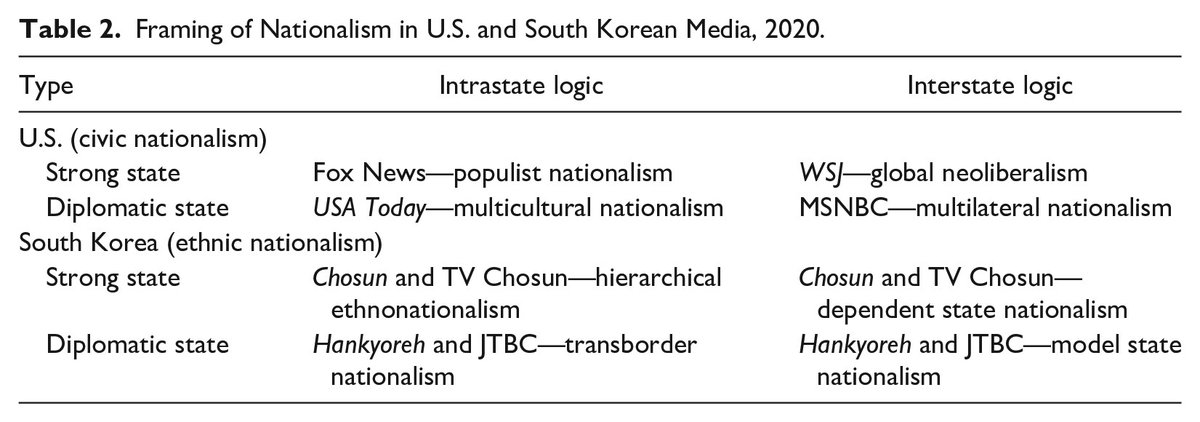How do the news media make sense of an unexpected global crisis that has marginalized various groups? By employing nationalism. Which media would do so under the polarized environment? Every kind of media, but in different ways.
Happy to share https://abs.twimg.com/emoji/v2/... draggable="false" alt="👇🏼" title="Rückhand Zeigefinger nach unten (mittelheller Hautton)" aria-label="Emoji: Rückhand Zeigefinger nach unten (mittelheller Hautton)">(1/7
https://abs.twimg.com/emoji/v2/... draggable="false" alt="👇🏼" title="Rückhand Zeigefinger nach unten (mittelheller Hautton)" aria-label="Emoji: Rückhand Zeigefinger nach unten (mittelheller Hautton)">(1/7 https://abs.twimg.com/emoji/v2/... draggable="false" alt="🧵" title="Thread" aria-label="Emoji: Thread">) https://journals.sagepub.com/doi/10.1177/07311214211005484">https://journals.sagepub.com/doi/10.11...
https://abs.twimg.com/emoji/v2/... draggable="false" alt="🧵" title="Thread" aria-label="Emoji: Thread">) https://journals.sagepub.com/doi/10.1177/07311214211005484">https://journals.sagepub.com/doi/10.11...
Happy to share
We conducted an inductive frame analysis on the US and South Korean media during the pandemic, 12/31/19-05/24/20. The nationalism narratives emerged as we read reports about actors who were exposed to racialized threats. (2/7 https://abs.twimg.com/emoji/v2/... draggable="false" alt="🧵" title="Thread" aria-label="Emoji: Thread">)
https://abs.twimg.com/emoji/v2/... draggable="false" alt="🧵" title="Thread" aria-label="Emoji: Thread">)
Consistent with nationalist cleavage lit, we find the nationalistic narratives are used for both inclusive/exclusive purposes within each country while keeping the distinction between (better) "us" and (worse) "them" (e.g., China or other & #39;successful/failed& #39; countries). (3/7 https://abs.twimg.com/emoji/v2/... draggable="false" alt="🧵" title="Thread" aria-label="Emoji: Thread">)
https://abs.twimg.com/emoji/v2/... draggable="false" alt="🧵" title="Thread" aria-label="Emoji: Thread">)
This divergence was caused by media competition. e.g., the pro-govt SK media developed the "model" nation story ("We respond better than other Western states"), while the counterpart press promoted the "dependent" nation image ("The govt& #39;s afraid of confronting the CCP.") (4/7 https://abs.twimg.com/emoji/v2/... draggable="false" alt="🧵" title="Thread" aria-label="Emoji: Thread">)
https://abs.twimg.com/emoji/v2/... draggable="false" alt="🧵" title="Thread" aria-label="Emoji: Thread">)
Another example: all Korean media expressed concern about the anti-Chinese discrimination, which was more active than the US media about anti-Asian racism. But the conservative media drew from the nativistic rhetoric when criticizing the govt. (5/7 https://abs.twimg.com/emoji/v2/... draggable="false" alt="🧵" title="Thread" aria-label="Emoji: Thread">)
https://abs.twimg.com/emoji/v2/... draggable="false" alt="🧵" title="Thread" aria-label="Emoji: Thread">)
Thus we add evidence to the varieties of nationalism studies urging us to overcome the monolithic or dichotomic view on nationalism. The pandemic amplified different conceptions of what our nation is and should be, which became a major source of the recent conflicts. (6/7 https://abs.twimg.com/emoji/v2/... draggable="false" alt="🧵" title="Thread" aria-label="Emoji: Thread">)
https://abs.twimg.com/emoji/v2/... draggable="false" alt="🧵" title="Thread" aria-label="Emoji: Thread">)
Appreciate co-authors and editors who have patiently worked together. Altho we sampled data, the inductive medium-n content analysis in a limited time was wild. Hope this can motivate future research to understand the various nationalisms that are present elsewhere (7/7 https://abs.twimg.com/emoji/v2/... draggable="false" alt="🧵" title="Thread" aria-label="Emoji: Thread">)
https://abs.twimg.com/emoji/v2/... draggable="false" alt="🧵" title="Thread" aria-label="Emoji: Thread">)
(+1) I deeply appreciate @letterhead234, who helps me to write this thread. I had no idea how much time I would need to summarize findings in a Twitter thread. If I successfully deliver some core ideas, that& #39;s because of her quick and kind editing.

 Read on Twitter
Read on Twitter )" title="Thus we add evidence to the varieties of nationalism studies urging us to overcome the monolithic or dichotomic view on nationalism. The pandemic amplified different conceptions of what our nation is and should be, which became a major source of the recent conflicts. (6/7https://abs.twimg.com/emoji/v2/... draggable="false" alt="🧵" title="Thread" aria-label="Emoji: Thread">)" class="img-responsive" style="max-width:100%;"/>
)" title="Thus we add evidence to the varieties of nationalism studies urging us to overcome the monolithic or dichotomic view on nationalism. The pandemic amplified different conceptions of what our nation is and should be, which became a major source of the recent conflicts. (6/7https://abs.twimg.com/emoji/v2/... draggable="false" alt="🧵" title="Thread" aria-label="Emoji: Thread">)" class="img-responsive" style="max-width:100%;"/>


